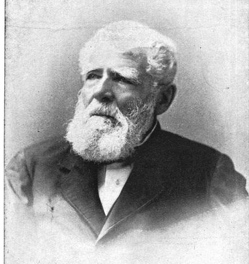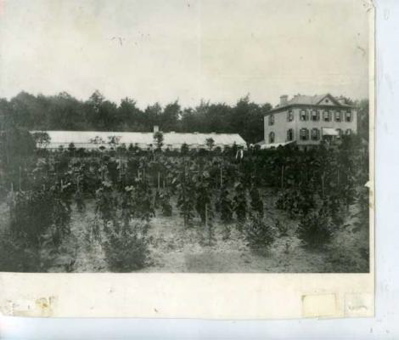How Menands got its name
(A version of this was previously published at All Over Albany.)
So, what is a Menand?
Well, the question really is, who was Menand?
For the answer, you’d have to look back to the late 1800s, when
everyone from well-to-do collectors of exotic flora, to prosperous
homeowners with gardens, to cemetery visitors who wanted to pay tribute
to a loved one — would go to Menand’s.
 Louis Menand was
Louis Menand was
the son of a gardener in Chalons, Burgundy, France. As early as he could
remember, he was fascinated by horticulture. “I was eight or nine years
old,” he later wrote, “when I began to try to grow plants from
cuttings. I have always been fond of cutting, properly or figuratively
speaking, except cutting my fingers.”
Eventually Louis became an estate gardener in Paris and later in the
Champagne region. In 1837 he came to New York and went to work at
nurseries in Halett’s Cove, which would later become Astoria. There he
met a young piano teacher from Albany named Adelaide Jackson. They
fell in love and were married in her family home on Park Place in
Albany, and soon took up residence in what they called “the haunted
house” on the Albany-Troy Road (Broadway). Louis began selling
plants. After a rough first year (“more than modest, that is to say
meagre, I might say miserable!!”), things began to pick up.
Menand had a fair collection of “hardy perennial plants,” which had
become pretty popular in the Albany/Troy area. Later he sold Norway
spruces, balsam firs and other popular trees and shrubs. In 1847 he
was able to buy several acres of land on what is now Menand Road, where
Ganser-Smith Park is now located, for his greenhouses and nursery.

He cultivated plants that, no doubt, had never before been seen in
this old Dutch town — camellias, palm ferns,
cacti, and orchids, among others. Forty years later, an article in The
Gardeners’ Monthly and Horticulturist would proclaim:
“It is Mr. Menand’s aim to exhibit at least one specimen of
every known variety ; and whenever a new one is produced in any quarter
of the world, it will not be long before it may be found at Menand’s.
Thus it often happens that persons who search in vain for rare specimens
in New York and elsewhere, are generally directed to ‘a crazy Frenchman
at Albany,’ where they are sure to find what they want and carry it
away, provided their purse is long enough. In fact, it is Mr. Menand’s
aim to furnish anything from a strawberry to a tree.”
He was noted for importing exotic plants from Europe, and commanded
an impressive price for his best camellias: “a little plant four inches
high would sell for $25.”
Menand won significant awards for his plants through the years, and
continued to grow. He bought 31 acres near the entrance to Albany Rural
Cemetery, where he set up his son with a half dozen hot houses devoted
to growing cut flowers, roses, carnations, pansies, geraniums and “an
almost endless variety of other species suitable for cemetery
decoration.” These included all manner of shrubs, which no doubt still
influence the scenery in the cemetery.
His greenhouses were so popular that the Albany and Northern Railroad
added a stop there in 1856, named “Menand’s Crossing,” which the
succeeding Delaware and Hudson Railroad renamed “Menand’s Station.”
Louis set about telling the story of his life in an autobiography,
with the snappy title, Autobiography
and Recollections of Incidents Connected With Horticultural Affairs,
Etc., From 1807 up to this day 1898 With Portrait and Allegorical
Figures. ‘By an ever practical wisdom seeker,’ L. Menand. With an
appendix of retrospective incidents omitted or forgotten.
The title is about as direct as the rest of the book, originally
published in 1892 and then updated in 1898. The ramblings of this
“crazy Frenchman at Albany” shed very little light on the actual events
of his life but give an incredible sense of the energetic character of
Louis Menand. There are exuberant paeans to his wife Adelaide (whom he
calls “Phanerogyne,” meaning “remarkable woman,” who died in 1890.
There are rambling thoughts on the various revolutions and republics in
France, a scathing appraisal of his arrival in a free land “where
slavery was flourishing as carnations,” and tales of intrigues at flower
exhibitions, all told in the least linear style imaginable. (The
version available here on Google Books includes several handwritten
notes by Louis.)
Louis Menand died in 1900 at the age of 94. It wasn’t until 1924 that
the apostrophe-free name of Menands became official, when the village
was incorporated.

